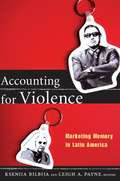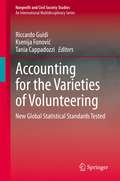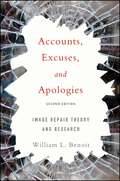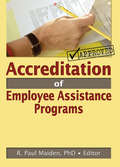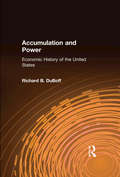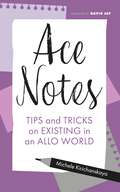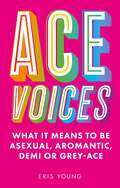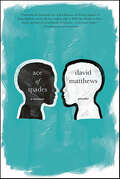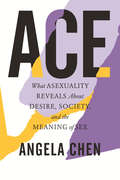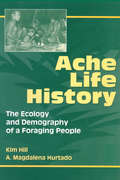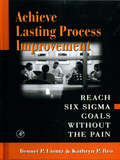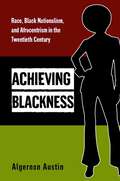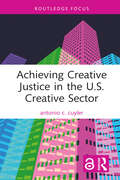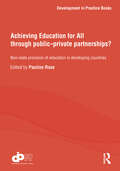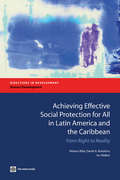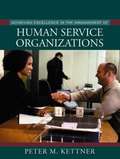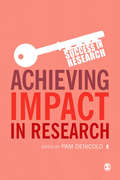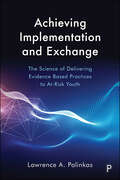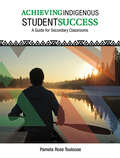- Table View
- List View
Accounting for Violence: Marketing Memory in Latin America
by Leigh A. Payne Ksenija BilbijaAccounting for Violence offers bold new perspectives on the politics of memory in Latin America. Scholars from across the humanities and social sciences provide in-depth analyses of the political economy of memory in Argentina, Brazil, Chile, Mexico, Peru, and Uruguay, countries that emerged from authoritarian rule in the 1980s and 1990s. The contributors take up issues of authenticity and commodification, as well as the "never again" imperative implicit in memory goods and memorial sites. They describe how bookstores, cinemas, theaters, the music industry, and television shows (and their commercial sponsors) trade in testimonial and fictional accounts of the authoritarian past; how tourist itineraries have come to include trauma sites and memorial museums; and how memory studies has emerged as a distinct academic field profiting from its own journals, conferences, book series, and courses. The memory market, described in terms of goods, sites, producers, marketers, consumers, and patrons, presents a paradoxical situation. On the one hand, commodifying memory potentially cheapens it. On the other hand, too little public exposure may limit awareness of past human-rights atrocities; such awareness may help to prevent their recurring. Contributors. Rebecca J. Atencio, Ksenija Bilbija, Jo-Marie Burt, Laurie Beth Clark, Cath Collins, Susana Draper, Nancy Gates-Madsen, Susana Kaiser, Cynthia E. Milton, Alice A. Nelson, Carmen Oquendo Villar, Leigh A. Payne, José Ramón Ruisánchez Serra, Maria Eugenia Ulfe
Accounting for the Varieties of Volunteering: New Global Statistical Standards Tested (Nonprofit and Civil Society Studies)
by Riccardo Guidi Ksenija Fonović Tania CappadozziFor a long time, volunteering lacked standardized data sets allowing methodologically robust comparative analyses and global policy making. Starting from 2011, the International Labour Office (ILO) and the United Nations (UN) have provided global statistical standards for organization-based and direct volunteering which offer path-breaking opportunities.The global statistical standards on volunteering are however only relatively known. They also have to face difficult methodological and substantial challenges: Can they really account for the local varieties of volunteering in the different areas of the world? Does their adoption further develop our knowledge of volunteering both at national and international level?Beyond illustrating which innovations these statistical standards bring and critically assessing the tensions between the global guidelines and the local differences, the book shows how the ILO and the UN standards can be implemented into national statistics and which advancements in the understanding of characters, antecedents and impacts of contemporary organization-based and direct volunteering they allow. The Volume takes Italy as an illustrative case that offers global value. This multidisciplinary book demonstrates that a holistic approach to the implementation of the ILO and UN guidelines permits to virtuously balance international statistical standards and locally embedded cultures as well as to move knowledge of volunteering forward in a complexity-driven agenda. The book provides tools, evidences and inspiration for scholars, statistical agencies, practitioners and policy-makers.
Accounts, Excuses, and Apologies, Second Edition: Image Repair Theory and Research
by William L. BenoitIn our constantly plugged-in and connected world, image is everything. People, groups, organizations, and countries frequently come under suspicion of wrongdoing and sometimes require defense. This fully updated edition of the 1994 volume investigates the situations in which threats to image arise and describes the image-repair strategies that may be used to help defuse these threats, such as denial and apology. The author reviews various theories on image repair, and extends prior research on the topic to include work on persuasion or attitude change.Five contexts for image repair are examined: corporate, political, sports/entertainment, international, and third party (when one person or organization tries to repair the image of another). New case studies include the British Petroleum oil spill in the Gulf of Mexico, Anthony Weiner, Lance Armstrong, Apple's apology to China over the iPhone, and Prime Minister David Cameron's apology for Bloody Sunday.
Accreditation of Employee Assistance Programs
by R Paul MaidenExplore the evolution, development, and applications of accreditation standards for employee assistance programs! Accreditation ensures private or public sector organizations that an employee assistance program (EAP) has an acceptable level of experience, advisement, and expertise. Accreditation of Employee Assistance Programs examines all facets of EAP accreditation while revealing the council on accreditation (COA) standards. Thorough and focused chapters discuss the value of EAP accreditation to future customers, the development of accreditation standards for employee assistance programs, and the smoothest road to travel to your destination of EAP accreditation.Accreditation of Employee Assistance Programs describes in depth the evolution, development, and applications of accreditation standards for EAPs. Respected authorities discuss the history and outlook of accreditation while providing valuable information on the entire process. Illustrative case studies provide further valuable insight. Accreditation of Employee Assistance Programs explores: the history of accreditation of EAPs in the United States and Canada EAP core technology the best strategies for developing standards for accreditation the COAs employee accreditation process in-depth accreditation case studies the future of credentialing and accreditation in EAPsThorough and informative, Accreditation of Employee Assistance Programs is of interest to those in employee assistance professions, benefits consultants, human resource managers, and students in the EAP field.
Accumulation and Power: Economic History of the United States
by Richard B. DuBoffKoreas location at the very center of Northeast Asia also gives it a pivotal role in the economic integration of the region and the dynamic development of its more powerful neighbors. This book offers an appraisal of Korea as the key to the coalescence of a broad, open Northeast Asian regionalism in the 21st century.
Accumulation: The Art, Architecture, and Media of Climate Change (e-flux Architecture)
by Nick Axel, Daniel A. Barber, Nikolaus Hirsch, Anton VidokleExamines how images of accumulation help open up the climate to political mobilization The current epoch is one of accumulation: not only of capital but also of raw, often unruly material, from plastic in the ocean and carbon in the atmosphere to people, buildings, and cities. Alongside this material growth, image-making practices embedded within the fields of art and architecture have proven to be fertile, mobile, and capacious. Images of accumulation help open up the climate to cultural inquiry and political mobilization and have formed a cultural infrastructure focused on the relationships between humans, other species, and their environments.The essays in Accumulation address this cultural infrastructure and the methodological challenges of its analysis. They offer a response to the relative invisibility of the climate now seen as material manifestations of social behavior. Contributors outline opportunities and ambitions of visual scholarship as a means to encounter the challenges emergent in the current moment: how can climate become visible, culturally and politically? Knowledge of climatic instability can change collective behavior and offer other trajectories, counteraccumulations that draw the present into a different, more livable, future.Contributors: Emily Apter, New York U; Hans Baumann; Amanda Boeztkes, U of Guelph; Dominic Boyer, Rice U; Lindsay Bremner, U of Westminster; Nerea Calvillo, U of Warwick; Beth Cullen, U of Westminster; T. J. Demos, U of California, Santa Cruz; Jeff Diamanti, U of Amsterdam; Jennifer Ferng, U of Sydney; Jennifer Gabrys, U of Cambridge; Ian Gray, U of California, Los Angeles; Gökçe Günel, Rice U; Orit Halpern, Concordia U; Gabrielle Hecht, Stanford U; Cymene Howe, Rice U; Wendy Hui Kyong Chun, Simon Fraser U; Robin Kelsey, Harvard U; Bruno Latour, Sciences Po, Paris; Hannah le Roux, U of the Witwatersrand, Johannesburg; Stephanie LeMenager, U of Oregon; Nashin Mahtani; Kiel Moe, McGill U; Karen Pinkus, Cornell U; Stephanie Wakefield, Life U; McKenzie Wark, The New School; Kathryn Yusoff, Queen Mary U of London.
Accumulation: The Material Politics of Plastic (CRESC)
by Jennifer Gabrys Gay Hawkins Mike MichaelFrom food punnets to credit cards, plastic facilitates every part of our daily lives. It has become central to processes of contemporary socio-material living. Universalised and abstracted, it is often treated as the passive object of political deliberations, or a problematic material demanding human management. But in what ways might a 'politics of plastics' deal with both its specific manifestation in particular artefacts and events, and its complex dispersed heterogeneity? Accumulation explores the vitality and complexity of plastic. This interdisciplinary collection focuses on how the presence and recalcitrance of plastic reveals the relational exchanges across human and synthetic materialities. It captures multiplicity by engaging with the processual materialities or plasticity of plastic. Through a series of themed essays on plastic materialities, plastic economies, plastic bodies and new articulations of plastic, the editors and chapter authors examine specific aspects of plastic in action. How are multiple plastic realities enacted? What are their effects? This book will be of interest to students and scholars of sociology, human and cultural geography, environmental studies, consumption studies, science and technology studies, design, and political theory.
Ace Notes: Tips and Tricks on Existing in an Allo World
by Michele KirichanskayaWhat is the ace lens?Is my relationship queerplatonic?Am I sex-favorable, sex-averse or sex-repulsed?As an ace or questioning person in an oh-so-allo world, you're probably in desperate need of a cheat sheet. Allow us to introduce your new asexual best friend, an essential resource serving up the life hacks you need to fully embrace the ace. Expect interviews with remarkable aces across the spectrum, advice on navigating different communities , and low-key ways to flaunt your ace identity.Covering everything from coming out, explaining asexuality and understanding different types of attraction, to marriage, relationships, sex, consent, gatekeeping, religion, ace culture and more, this is the ultimate arsenal for whatever the allo world throws at you.
Ace Voices: What it Means to Be Asexual, Aromantic, Demi or Grey-Ace
by Eris YoungHow do we experience attraction?What does love mean to us?When did you realise you were ace?This is the ace community in their own words. Drawing upon interviews with a wide range of people across the asexual spectrum, Eris Young is here to take you on an empowering, enriching journey through the rich multitudes of asexual life. With chapters spanning everything from dating, relationships and sex, to mental and emotional health, family, community and joy, the inspirational stories and personal experiences within these pages speak to aces living and loving in unique ways. Find support amongst the diverse narratives of aces sex-repulsed and sex-favourable, alongside voices exploring what it means to be black and ace, to be queer and ace, or ace and multi-partnered - and use it as a springboard for your own ace growth. Do you see a story like your own?
Ace of Spades: A Memoir
by David MatthewsA take-no-prisoners tale of growing up without knowing who you are.When David Matthews's mother abandoned him as an infant, she left him with white skin and the rumor that he might be half Jewish. For the next twenty years, he would be torn between his actual life as a black boy in the ghetto of 1980s Baltimore and a largely imagined world of white privilege.While his father, a black activist who counted Malcolm X among his friends, worked long hours as managing editor at the Baltimore Afro-American, David spent his early years escaping wicked-stepmother types and nursing an eleven-hour-a-day TV habit alongside his grandmother in her old-folks-home apartment. In Reagan-era America, there was no box marked "Other," no multiculturalism or self-serving political correctness, only a young boy's need to make it in a clearly segregated world where white meant "have" and black meant "have not." Without particular allegiance to either, David careened in and out of community college, dead-end jobs, his father's life, and girls' pants. A bracing yet hilarious reinvention of the American story of passing, Ace of Spades marks the debut of an irresistible and fiercely original new voice.
Ace: What Asexuality Reveals About Desire, Society, and the Meaning of Sex
by Angela ChenAn engaging exploration of what it means to be asexual in a world that's obsessed with sexual attraction, and what the ace perspective can teach all of us about desire and identity. <P><P>What exactly is sexual attraction and what is it like to go through life not experiencing it? What does asexuality reveal about gender roles, about romance and consent, and the pressures of society? This accessible examination of asexuality shows that the issues that aces face--confusion around sexual activity, the intersection of sexuality and identity, navigating different needs in relationships--are the same conflicts that nearly all of us will experience. Through a blend of reporting, cultural criticism, and memoir, Ace addresses the misconceptions around the "A" of LGBTQIA and invites everyone to rethink pleasure and intimacy. <P><P> Journalist Angela Chen creates her path to understanding her own asexuality with the perspectives of a diverse group of asexual people. Vulnerable and honest, these stories include a woman who had blood tests done because she was convinced that "not wanting sex" was a sign of serious illness, and a man who grew up in a religious household and did everything "right," only to realize after marriage that his experience of sexuality had never been the same as that of others. Disabled aces, aces of color, gender-nonconforming aces, and aces who both do and don't want romantic relationships all share their experiences navigating a society in which a lack of sexual attraction is considered abnormal. Chen's careful cultural analysis explores how societal norms limit understanding of sex and relationships and celebrates the breadth of sexuality and queerness.
Ache Life History: The Ecology and Demography of a Foraging People (Foundations of Human Behavior)
by Kim Hill A.Magdalena HurtadoThe Ache, whose life history the authors recounts, are a small indigenous population of hunters and gatherers living in the neotropical rainforest of eastern Paraguay. This is part exemplary ethnography of the Ache and in larger part uses this population to make a signal contribution to human evolutionary ecology.
Achieve Lasting Process Improvement
by Bennet Lientz Kathryn ReaMethods of improving business processes are developed on an ongoing basis, but few are successful. Common problems encountered include the failure of processes to meet expectations and the inability to sustain or replicate these business processes. Involvement of personnel at grassroots level, as well as at management level, is essential in implementing effective process improvement methods. The authors present a step-by-step approach to the issue of effective process improvement, offering more than 200 tips and guidelines as well as addressing specific common problems and issues. The strategy presented is to take a broad and intuitive, but learned view of process improvement methods, and the tactics expounded are based on guidelines, common faults, and lessons learned. The authors disparage process improvement operations that depend on jargon and the support of just upper management, and promote grassroots involvement and self-sustaining measurement, making this an essential guide for all with involvement in process improvement.
Achieving Blackness: Race, Black Nationalism, and Afrocentrism in the Twentieth Century
by Algernon AustinAchieving Blackness offers an important examination of the complexities of race and ethnicity in the context of black nationalist movements in the United States. By examining the rise of the Nation of Islam, the Black Power Movement of the 1960s and 1970s, and the “Afrocentric era” of the 1980s through 1990s Austin shows how theories of race have shaped ideas about the meaning of “Blackness” within different time periods of the twentieth-century. Achieving Blackness provides both a fascinating history of Blackness and a theoretically challenging understanding of race and ethnicity. Austin traces how Blackness was defined by cultural ideas, social practices and shared identities as well as shaped in response to the social and historical conditions at different moments in American history. Analyzing black public opinion on black nationalism and its relationship with class, Austin challenges the commonly held assumption that black nationalism is a lower class phenomenon. In a refreshing and final move, he makes a compelling argument for rethinking contemporary theories of race away from the current fascination with physical difference, which he contends sweeps race back to its misconceived biological underpinnings. Achieving Blackness is a wonderful contribution to the sociology of race and African American Studies.
Achieving Competence in Social Work through Field Education
by Marion BogoField education is considered by social workers to be the most crucial part of their professional preparation, as it allows students to engage with communities, apply theoretical concepts, and develop their skill sets. In Achieving Competence in Social Work Through Field Education, Marion Bogo synthesizes current and emerging knowledge on field education with the latest findings in the empirical literature.Bogo, an international leader in social work field education, has published extensively in the field. This new book delves into the rich theoretical and practical knowledge advancements of recent years to synthesize the processes that facilitate hands-on learning. With in-depth frameworks, approaches, and educational principles, as well as an appendix of evaluation tools, Bogo's writing is both insightful and widely applicable. Achieving Competence in Social Work through Field Education is accessible for faculty members, field instructors, and students who are looking to explore the possibilities of field teaching and learning in social work.
Achieving Creative Justice in the U.S. Creative Sector (Routledge Focus on the Global Creative Economy)
by antonio c. cuylerCaste and the discrimination, exclusion, marginalization, othering, oppression, subalterning, and subjugation that it produces continue to challenge creative industries compromising culture’s verisimilitude as a public good. Achieving Creative Justice in the U.S. Creative Sector explores the relationships between access, diversity, equity, and inclusion (ADEI), and creative justice in the U.S. creative sector as a solution to meaningfully address enduring creative injustices.Whether it’s the #BlackLivesMatter, #LandBack, or #MeToo movements, caste remains structurally and systemically built into U.S. Society, and thereby the creative sector. Acknowledging this realization after George Floyd’s murder in 2020 has galvanized a quest for solutions. This book encourages sincere consideration for the human toll of insisting on artistic excellence and artistic merit at the expense of profound and unnecessary identity-based human suffering.Providing a practical guide on how to activate ADEI to achieve creative justice and a research agenda, this book is an essential reading for practitioners and scholars who feel compelled to address creative injustices that constrain the creative flourishing of historically and continuously low-casted peoples throughout the entire cultural ecosystem that defines the U.S. creative sector.The Open Access version of this book, available at http://www.taylorfrancis.com, has been made available under a Creative Commons [Attribution-Non Commercial-No Derivatives (CC BY-NC-ND)] 4.0 license.
Achieving Education for All through Public–Private Partnerships?: Non-State Provision of Education in Developing Countries (Development in Practice Books)
by Pauline RoseConcern for achieving Millennium Development Goals (MDGs) by 2015 has led to a focus on the role that non-state providers (NSPs) can offer in extending access and improving quality of basic services. While NSPs can help to fill a gap in provision to those excluded from state provision, recent growth in both for-profit and not-for-profit providers in developing countries has sometimes resulted in fragmentation of service delivery. To address this, attention is increasingly given in the education sector to developing ‘partnerships’ between governments and NSPs. Partnerships are further driven by the expectation that the state has the moral, social, and legal responsibility for overall education service delivery and so should play a role in facilitating and regulating NSPs.Even where the ultimate aim of both non-state providers and the state is to provide education of acceptable quality to all children, this book provides evidence from diverse contexts across Africa, South Asia, and Latin America to highlight the challenges in them partnering to achieve this. This book was published as a special issue of Development in Practice.
Achieving Effective Social Protection for All in Latin America and the Caribbean
by David A. Robalino Helena Ribe Ian WalkerThis study highlights the interaction between social protection programs and labor markets in the Latin America region. It presents new evidence on the limited coverage of existing programs and emphasizes the challenges caused by high informality for achieving universal social protection for old age income, for health, for unemployment risks and for anti poverty safety nets. It identifies interaction effects between SP programs and the behavioral responses of workers, firms and social protection providers, which can further undermine efforts to expand coverage, summarizing evidence from recent work across the region. It argues for a re-design of financing to eliminate cross subsidies between members of contributory programs and subsidies that effectively tax income from formal employment. Instead, it advocates well-targeted, tax-funded tapered subsidies to provide incentives to the savings efforts of low income workers, coupled with an effective safety net for the extreme poor who have no capacity to contribute to financing their own social protection arrangements. It also argues for the consolidation of programs and harmonization of benefits packages across different insurers. The book develops an overall conceptual framework and presents in-depth analysis of the main SP sectors of pensions, health, unemployment insurance and safety net transfers.
Achieving Excellence in the Management of Human Service Organizations
by Peter M. KettnerA complete guide to human resources management at the corporate level.
Achieving Gender Justice through Education: The Hidden Curriculum and Its Implications in Indian Schools
by Arpan TulsyanThis book delves into the uncharted territories of how gender dynamics subtly shape educational experiences in Indian schools. While traditional educational reforms focus on increasing enrolment and making textbooks more inclusive, this book highlights the overlooked yet powerful influence of “hidden curriculum” – the implicit lessons that subtly shape students’ views on gender, caste, class, and religion.Positioned in feminist cultural reproduction perspective and informed by capability approach, this book explores education as an object of demand, a conduit for diffusion of ideas, and a site for gender activism. It provides a critical analysis of how schools can be transformed into spaces of empowerment, negotiation, and resistance for all students. Drawing on immersive research that challenges ordinary interactions and processes, it expands our understanding of what constitutes curriculum and knowledge.Particularly useful for educationists, educators, policymakers, academics, curriculum developers, teacher training institutes, gender studies departments, and university centres offering educational studies courses, this book offers a captivating read for anyone interested in examining their own educational experiences.
Achieving Impact in Research (Success in Research)
by Pam DenicoloThis unique addition to the Success in Research series addresses the importance of understanding and achieving impact for the purposes of gaining research funding and reporting achieved impact for the Research Excellence Framework (REF). The book includes contributions from researchers and researcher developers who feel that impact is ill-defined and poorly understood despite its prevalence in policy documents, websites and institutional activities. This succinct and cohesive text draws on the expert contributors' collective research practice, knowledge and experience. Using a variety of examples, boxed activities and highlighted reflection points, this practical guide covers the following key areas: - The meaning of impact in relation to research - How the Impact Agenda fits with attitudes and ethics that motivate research - The different characterisations of research impact and when impact is apparent - How impact can be planned into proposals, evaluated and evidenced - The skills needed to be an impactful researcher - How impact can be supported through Knowledge Exchange and effective partnerships This is a must-have guide for anyone seeking to understand and achieve impact in their own research.
Achieving Implementation and Exchange: The Science of Delivering Evidence-Based Practices to At-Risk Youth
by Lawrence A. PalinkasConverting research evidence into practice is an issue of growing importance to many fields of policy and practice worldwide. This book, by a leading implementation specialist in child welfare and mental health, addresses the frustrating gap between research conducted on effective practices and the lack of routine use of such practices. Drawing on implementation science, the author introduces a model for reducing the gap between research and practice. This model highlights the roles of social networks, research evidence, practitioner/policymaker decision-making, research-practice-policy partnerships, and cultural exchanges between researchers and practitioners and policymakers. He concludes with a discussion of how the model may be used to develop more widespread use of evidence-based practices for the prevention and treatment of behavioural and mental health problems in youth-serving systems of care, as well as partnerships that promote ongoing quality improvement in services delivery.
Achieving Inclusive Education in the Caribbean and Beyond: From Philosophy to Praxis
by Dennis A. Conrad Launcelot I. Brown Stacey N. BlackmanThis book offers an international perspective of philosophical, conceptual and praxis-oriented issues that impinge on achieving education for all students. It sheds light on the historical, systemic, structural, organizational, and attitudinal barriers that continue to be antithetical to the philosophy and practice of inclusive education within the Caribbean. The first section of the book examines how globalized views of inclusion informed by philosophical ideas from the North have influenced and continue to influence the equity in education agenda in the region. The second section considers how exclusion and marginalization still occur across selected Caribbean islands. It provides both quantitative and qualitative data about the nature and experience of exclusion in selected Caribbean islands, the UK and USA. The third section tackles the practical realities of transforming education systems in the Caribbean for inclusion. In particular, it identifies teacher practices as the main site of interrogation that needs to be tackled if inclusion is to be successful. The fourth and final section examines the contribution of principals and exemplars to the development and advocacy for inclusive education. It discusses how educational leadership is understood, as well as the role of school principals in making inclusion a reality in schools, the challenges experienced and the qualities of education leaders.
Achieving Indigenous Student Success: A Guide for Secondary Classrooms
by Pamela Rose ToulouseIn Achieving Indigenous Student Success, author Pamela Toulouse provides strategies, lessons, and hands-on activities that support both Indigenous and non-Indigenous learners in the secondary classroom. Read chapters on topics such as:Indigenous Pedagogy and Classrooms ConsiderationsIndigenous Self-Esteem and Mental Health ActivitiesDifferentiated Instruction and Bloom's TaxonomyAttrition, Retention, Transition, and Graduation ContinuumIndigenous Themes and Material ResourcesCulturally Appropriate Secondary Lesson Plans by Subject (including English, Math, Science, History, Geography, Health, Physical Education, Drama, Music, Visual Arts, Technological Studies, Business Studies, Indigenous Worldviews, Guidance and Career Studies, and Social Studies and the Humanities)This book is for all teachers of grades 9–12 who are looking for ways to infuse Indigenous perspectives into their courses. Ideas include best practices for retention/transition/graduation planning, differentiated instruction, assessment, and equity instruction. Using appropriate themes for curricular connections, the author presents a culturally relevant and holistic approach that helps to build bridges between cultures and fosters self-esteem in all students.
Achieving Indigenous Student Success: A Guide for Secondary Classrooms
by Pamela Rose ToulouseIn Achieving Indigenous Student Success, author Pamela Toulouse provides strategies, lessons, and hands-on activities that support both Indigenous and non-Indigenous learners in the secondary classroom. Read chapters on topics such as:Indigenous Pedagogy and Classrooms ConsiderationsIndigenous Self-Esteem and Mental Health ActivitiesDifferentiated Instruction and Bloom's TaxonomyAttrition, Retention, Transition, and Graduation ContinuumIndigenous Themes and Material ResourcesCulturally Appropriate Secondary Lesson Plans by Subject (including English, Math, Science, History, Geography, Health, Physical Education, Drama, Music, Visual Arts, Technological Studies, Business Studies, Indigenous Worldviews, Guidance and Career Studies, and Social Studies and the Humanities)This book is for all teachers of grades 9–12 who are looking for ways to infuse Indigenous perspectives into their courses. Ideas include best practices for retention/transition/graduation planning, differentiated instruction, assessment, and equity instruction. Using appropriate themes for curricular connections, the author presents a culturally relevant and holistic approach that helps to build bridges between cultures and fosters self-esteem in all students.
